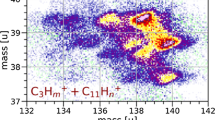Abstract
By means of refinements in the modulated molecular beam technique the signal-to-noise ratio can be greatly improved, and differential cross-sections, for collision of molecuies of the same species, can be measured. This was accomplished by combining beam modulation and phase sensitive detection with very sharp turning on the front end of the lock-in-amplifier and long integration times on the output. In addition, the signal-to-noise ratio of the Ar-Ar system as a function of integration time was investigated using two different types of electron bombardment detectors an Aberth ion-source and a quadrupole mass filter. With an integration time of 40 min the estimated upper limit to the signal-to-noise ratio is 1500 to 1 for the Aberth ion-source. Using quadrupole mass filter with an integration time of 60 min the estimated upper limit to the signal-to-noise ratio is 5 × 104 to 1. For chemical kinetics studies this ratio may be two orders of magnitude higher.
Similar content being viewed by others
References
Brackman R T and Fite W L 1961J. Chem. Phys. 34 1572
Bennewitz H G and Wedemeyer R 1963Z. Phys. 172 1
Knaur F 1933Z. Phys. 80 80
Landorf R W and Mueller C R 1966J. Chem. Phys. 45 240
Luoma J and Mueller C R 1965Disc. Faraday Soc. 40 45
Minturn R E, Datz S and Tayler E H 1960J. Appl. Phys. 31 876
Mueller C R and Marchi R P 1963J. Chem. Phys. 38 745
Mueller C R, Smith B, McGuise P, Williams W, Chakrabarti P and Penta J 1971Adv. Chem. Phys. (California: John Wiley & Sons),21 369
Penta J, Mueller C R, Williams W, Olson R and Chakraborti P 1967Phys. Lett. A25 658
Zabel 1933Phys. Rev. 44 53
Author information
Authors and Affiliations
Additional information
Measurements were carried out at the Purdue University, Lafayette, Indiana, USA.
Rights and permissions
About this article
Cite this article
Chakraborti, P.K. Detection of modulated molecular beams with electron bombardment detectors. Pramana - J Phys 11, 307–311 (1978). https://doi.org/10.1007/BF02848192
Received:
Revised:
Issue Date:
DOI: https://doi.org/10.1007/BF02848192




